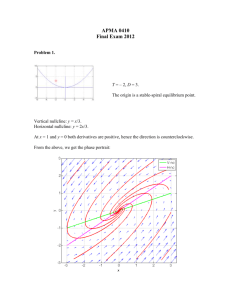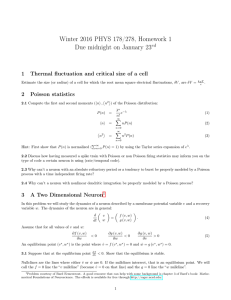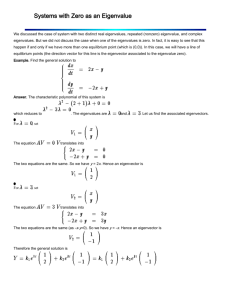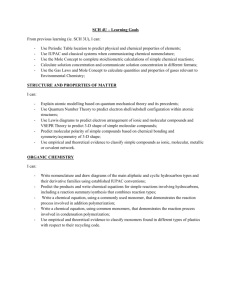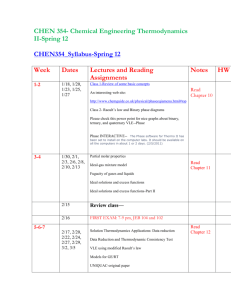hw6_solutions
advertisement
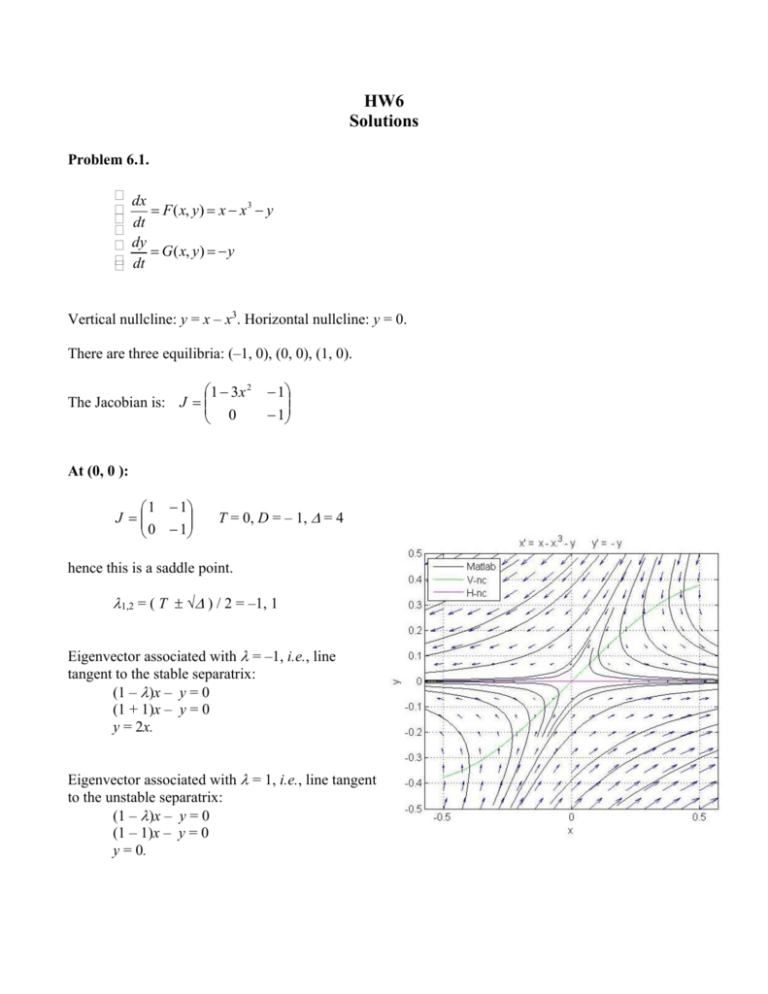
HW6 Solutions Problem 6.1. ì ï ï í ï ïî dx = F(x, y) = x - x 3 - y dt dy = G(x, y) = -y dt Vertical nullcline: y = x – x3. Horizontal nullcline: y = 0. There are three equilibria: (–1, 0), (0, 0), (1, 0). 1 3x 2 The Jacobian is: J 0 1 1 At (0, 0 ): 1 1 J 0 1 T = 0, D = – 1, = 4 hence this is a saddle point. 1,2 = ( T ) / 2 = –1, 1 Eigenvector associated with = –1, i.e., line tangent to the stable separatrix: (1 – )x – y = 0 (1 + 1)x – y = 0 y = 2x. Eigenvector associated with = 1, i.e., line tangent to the unstable separatrix: (1 – )x – y = 0 (1 – 1)x – y = 0 y = 0. At (–1, 0) and (1, 0): 2 1 J 0 1 T = –3, D = 2, = 1 (below the parabola D = T2/4). 1,2 = ( T ) / 2 = –1, –2 hence these are stable nodes. Eigenvector associated with = –1: (–2 – )x – y = 0 (–2 + 1)x – y = 0 y = – x. Eigenvector associated with = –2: (–2 – )x – y = 0 (–2 + 2)x – y = 0 y = 0. The eigenvector analysis shows that at each of the two equilibria (–1, 0) and (1, 0) the trajectories approach the node as they become tangent to the slow eigendirection y = –x. The behavior in the immediate vicinity of these two equilibria is the same, since the linearized system at both equilibria is the same. Yet as we move away from the equilibria, the behavior in each equilibrium gradually becomes different. Putting it all together: The phase portrait possesses central symmetry, i.e., it remains unchanged under point reflection through the origin. This is due to the fact that F(–x, –y) = – F(x, y) and G(–x, –y) = – G(x, y). The basins of attraction of the two point attractors are delimited by the separatrices in a straightforward fashion (not shown in the diagram above). Far from the origin and from the vertical nullcline, the term – x3 dominates in the derivatives, hence all trajectories, including separatrices, bend and eventually becomes nearly parallel to the x-axis. Thus, the basin of attraction of (–1,0) contains all of the half plane y > 0 except for a horizontal “band” starting around 1 and extending to . The basin of attraction of (1,0) is obtained by point reflection through the origin. Like the Fitzhugh-Nagumo model (FN), this system has a cubic vertical nullcline with a hump, and a linear horizontal nullcline. Like the FN model, the system is globally stable, meaning that trajectories don’t go off to infinity. Like in the FN model, a trajectory that approaches the right branch of the cubic V-NC from the lower left first crosses the nullcline and then slowly rises along the hump. However, in the FN model, the trajectory eventually escapes from the hump and falls back on the right branch of the cubic, because there is no equilibrium on the right branch of the cubic. Here, there is an equilibrium and it is stable. Therefore, the trajectory ends there. In short, the difference in behavior comes from the existence of three equilibrium points instead of just one in the FN model. Problem 6.2. ì ï ï í ï ïî dx = y - x3 dt dy = y-x dt Vertical nullcline: y = x3. Horizontal nullcline: y = x. There are three equilibria: (–1, –1), (0, 0), (1, 1). 3x 2 1 Jacobian: J 1 1 At (–1, –1) and (1, 1): 3 1 J 1 1 T = –2, D = –2, hence these are saddle points. At (0, 0): 0 1 J 1 1 T = 1, D = 1, = –3, hence this is an unstable spiral. Putting it all together: There are two common features with Problem 6.1, for exactly the same reasons: the phase portrait possesses central symmetry; far from the origin and from the vertical nullcline, the term – x3 dominates in the derivatives, hence all trajectories, including separatrices, bend and eventually becomes nearly parallel to the x-axis. All trajectories, except for separatrices, go to either (+,+) or to (–,–). The two downward pointing separatrices eventually approach each other and remain close to the vertical nullcline; these separatrices attract all the points in the basin of attraction represented in yellow in the diagram. Because of symmetry, all the points in the white region are attracted by the merging two separatrices that point upward. The two basins of attraction wrap around each other at the origin. Problem 6.3. ì ï ï í ï ïî dx = F(x, y) = xy dt dy = G(x, y) = 1- x 2 - y 2 dt The vertical nullclines are the x and y axes. The horizontal nullcline is the circle of radius 1 centered at the origin. There are four equilibria: (1,0), (–1,0), (0,1), (0, –1). The Jacobian is: y x –2x –2y At (1,0): 0 1 –2 0 T = 0, D = 2; the T-D analysis is inconclusive, but this is actually a center. At (–1,0): 0 –1 +2 0 T = 0, D = 2; the T-D analysis is inconclusive, but this is actually a center. At (0,1): 1 0 0 –2 T = –1, D = –2; saddle point At (0, –1): –1 0 0 2 T = 1, D = –2; saddle point The phase portrait possesses axial symmetry across the y-axis, because F(–x, y) = – F(x, y) and G(–x, y) = G(x, y). There are two types of trajectories (other than fixed points and separatrices): closed orbits around the fixed points (1,0) and (–1,0); trajectories that start at (0,+) and end at (0,–). Problem 6.4. ì dx ï = (x +1)y ï dt í ï dy = y - y 2 - x +1 ïî dt The linearization is straightforward, showing the existence of three equilibrium points: two saddles and one unstable spiral. All trajectories starting to the right of the line x = –1 except for the unstable fixed point (1,0) converge to (–1, –). Trajectories starting to the left of the line x = –1 converge either to (–1, –) or to (–, –) along the upper branch of the parabola, depending on whether they start below or above the left stable separatrix into saddle point (–1, –1). (This separatrix hugs the lower branch of the parabola from above.) Note that the right stable separatrix into saddle point (–1, –1) wraps itself around the spiral point when t goes to –. This separatrix determines how many times a trajectory will circle around the unstable equilibrium point (1, 0) before going to (–1, –).
